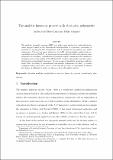Files in this item
The analytic hierarchy process with stochastic judgements
Item metadata
| dc.contributor.author | Durbach, Ian Noel | |
| dc.contributor.author | Lahdelma, Risto | |
| dc.contributor.author | Salminen, Pekka | |
| dc.date.accessioned | 2020-10-28T13:30:05Z | |
| dc.date.available | 2020-10-28T13:30:05Z | |
| dc.date.issued | 2014-10 | |
| dc.identifier | 270836675 | |
| dc.identifier | 687fb65e-8d43-4f2b-9c09-a74dbb2055b0 | |
| dc.identifier | 84901650261 | |
| dc.identifier.citation | Durbach , I N , Lahdelma , R & Salminen , P 2014 , ' The analytic hierarchy process with stochastic judgements ' , European Journal of Operational Research , vol. 238 , no. 2 , pp. 552-559 . https://doi.org/10.1016/j.ejor.2014.03.045 | en |
| dc.identifier.issn | 0377-2217 | |
| dc.identifier.other | ORCID: /0000-0003-0769-2153/work/82501103 | |
| dc.identifier.uri | https://hdl.handle.net/10023/20846 | |
| dc.description.abstract | The analytic hierarchy process (AHP) is a widely-used method for multicriteria decision support based on the hierarchical decomposition of objectives, evaluation of preferences through pairwise comparisons, and a subsequent aggregation into global evaluations. The current paper integrates the AHP with stochastic multicriteria acceptability analysis (SMAA), an inverse-preference method, to allow the pairwise comparisons to be uncertain. A simulation experiment is used to assess how the consistency of judgements and the ability of the SMAA-AHP model to discern the best alternative deteriorates as uncertainty increases. Across a range of simulated problems results indicate that, according to conventional benchmarks, judgements are likely to remain consistent unless uncertainty is severe, but that the presence of uncertainty in almost any degree is sufficient to make the choice of best alternative unclear. | |
| dc.format.extent | 8 | |
| dc.format.extent | 301789 | |
| dc.language.iso | eng | |
| dc.relation.ispartof | European Journal of Operational Research | en |
| dc.subject | Decision analysis | en |
| dc.subject | Multicriteria | en |
| dc.subject | Analytic hierarchy process | en |
| dc.subject | Uncertainty | en |
| dc.subject | Simulation | en |
| dc.subject | QA Mathematics | en |
| dc.subject.lcc | QA | en |
| dc.title | The analytic hierarchy process with stochastic judgements | en |
| dc.type | Journal article | en |
| dc.contributor.institution | University of St Andrews. School of Mathematics and Statistics | en |
| dc.contributor.institution | University of St Andrews. Centre for Research into Ecological & Environmental Modelling | en |
| dc.identifier.doi | https://doi.org/10.1016/j.ejor.2014.03.045 | |
| dc.description.status | Peer reviewed | en |
This item appears in the following Collection(s)
Items in the St Andrews Research Repository are protected by copyright, with all rights reserved, unless otherwise indicated.

